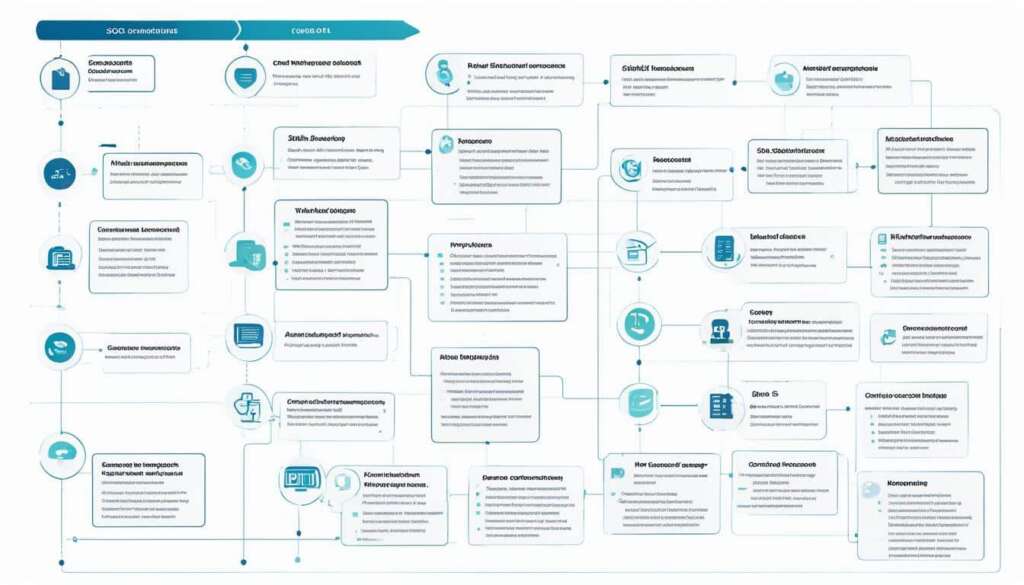Table of Contents
A SOC 1 report, also known as a Report on Controls at a Service Organisation Relevant to User Entities’ Internal Control over Financial Reporting (ICFR), is an audit report that evaluates the controls at a service organisation that impact the financial statements of user entities. These reports are important for service organisations that outsource processes that can impact the financial statements of their clients, such as payroll processors or data centre companies.
SOC 1 reports are prepared by CPA firms specialising in IT security and business process controls. There are two types of SOC 1 reports: Type 1, which evaluates the controls as of a specific date, and Type 2, which evaluates the controls over a specified period. In this guide, we will explore what SOC 1 reports are, why they are important, and how they are used in the world of financial reporting.
What is a SOC 1 Audit Report & Who Can Perform One?
A SOC 1 audit report is a comprehensive report that evaluates both business process and IT control objectives and testing. It is issued by a Certified Public Accountant (CPA) firm that specializes in auditing IT security and business process controls. The report is tailored to the specific service organization and does not have a standard set of requirements. In a SOC 1 report, management asserts that certain controls are in place to meet the control objectives included in the report, and the CPA firm tests these controls to provide an opinion on whether they agree with management’s assertion.
The SOC 1 report serves as a critical tool in assessing the effectiveness of internal controls relevant to user entities’ financial reporting. It provides assurance to user entities and financial statement auditors that the service organization has implemented appropriate controls to support the achievement of control objective statements. The report may include an unqualified opinion, often referred to as a “clean” report, indicating that the controls are effective, or a qualified opinion if control objectives are not fully met.
Here is an example of the components typically included in a SOC 1 audit report:
Business Process Control Objectives: These are the aims or purposes of controls within specific process areas. They address the risks that the controls are designed to mitigate.
IT Control Objectives: These are the aims or purposes of controls related to information technology systems and infrastructure.
Audit Procedures: This section outlines the detailed procedures performed by the CPA firm to test the control objectives.
Management Assertion: This section contains management’s statements regarding the existence and effectiveness of the controls.
Audit Opinion: This section provides the CPA firm’s opinion on the effectiveness of the controls based on the testing performed.
Additional Information: This section may include any additional information deemed relevant to the report, such as limitations on the scope of the audit procedures.
By obtaining a SOC 1 audit report, service organizations demonstrate their commitment to maintaining strong internal controls, which can enhance customer trust and foster confidence in their financial reporting. It also allows user entities to place reliance on the outsourced processes and minimize the need for performing their own audit procedures.
Control Objectives and Uses of SOC 1 Reports
In SOC 1 reports, control objectives play a vital role in ensuring the effectiveness of controls within a specific process area. These control objectives are designed to mitigate risks that can impact the financial reporting of user entities. By addressing these risks, service organizations can provide assurance to financial statement auditors and user entities, enabling them to rely on the outsourced processes without performing additional audit procedures.
Financial statement auditors of user entities utilize SOC 1 reports to assess the controls implemented by service organizations. These reports help auditors place reliance on the processes performed by service organizations, allowing them to focus their efforts on other areas of the audit. By relying on the SOC 1 report, auditors can gain a comprehensive understanding of the controls in place and make informed decisions regarding the reliability and accuracy of the financial statements.
User entities receive SOC 1 reports to evaluate the controls at the service organization that have an impact on their internal control over financial reporting (ICFR). These reports enable user entities to assess the adequacy and effectiveness of the controls implemented by the service organization. By reviewing the SOC 1 report, user entities can gain assurance that the service organization has established controls that support the achievement of control objective statements.
Control Objective Examples
| Control Objective | Description |
|---|---|
| Access Control | Ensure that access to systems, applications, and data is appropriately restricted based on the user’s role and responsibilities. |
| Change Management | Ensure that changes to systems, applications, and infrastructure are planned, approved, and implemented in a controlled manner to avoid unintended impacts on financial reporting. |
| Backup and Recovery | Establish mechanisms to regularly back up critical data and implement procedures to recover data in the event of a system failure or data loss. |
| Incident Response | Define processes and procedures to detect, respond to, and recover from security incidents or breaches to safeguard financial reporting systems and data. |
By incorporating control objectives and evaluating the controls through SOC 1 reports, service organizations and user entities can ensure the integrity and reliability of financial reporting processes. These reports serve as a valuable tool for assessing and improving the control environment, providing transparency and confidence to all stakeholders involved in the financial reporting ecosystem.
Service Organizations and the Need for SOC 1 Reports
A service organisation, also known as a company that provides outsourced services to other companies, plays a crucial role in supporting the processes that their clients have entrusted to them. However, when it comes to service organizations that can potentially impact the financial statements of their clients, there arises a need for a SOC 1 (System and Organization Controls 1) report. This report serves as an important requirement for service organizations in ensuring the effectiveness of their internal controls over financial reporting (ICFR).
Consider the example of payroll processors or datacenter companies, which can have a material impact on the financials of their clients. In such cases, obtaining a SOC 1 report becomes essential. This report helps clients and stakeholders gain the necessary assurance that the service organization has established and maintained certain IT general controls and business process-related controls.
The requirement for a SOC 1 report primarily depends on the potential impact that a service organization can have on the user entities’ ICFR. By evaluating the controls at a service organization, the SOC 1 report provides insights into the existence and effectiveness of these controls, offering transparency and confidence to clients and stakeholders.
To further illustrate the significance of SOC 1 reports, let’s take a closer look at the potential impact they can have on various aspects:
“The SOC 1 report requirement forms an integral part of maintaining accountability and trust between service organizations and their clients. It ensures that proper controls are in place, reducing the risk of financial misstatements and providing clients with peace of mind.”
Key Benefits of SOC 1 Reports for Service Organizations:
- Providing evidence of strong internal controls to clients and stakeholders.
- Demonstrating compliance with industry standards and regulations.
- Building trust and credibility with clients.
- Enhancing client satisfaction and retention.
Potential Impact of SOC 1 Reports on User Entities:
| Impact | Description |
|---|---|
| Confidence in Financial Reporting | SOC 1 reports assure user entities that the service organization’s controls are effective in mitigating risks related to financial reporting. |
| Reduced Audit Effort | By relying on SOC 1 reports, user entities can reduce the need for conducting their own audit procedures, saving time and resources. |
| Compliance and Risk Mitigation | SOC 1 reports help user entities demonstrate compliance with regulatory requirements and mitigate the risks associated with outsourcing critical processes. |
| Enhanced Supplier Management | The availability of SOC 1 reports allows user entities to evaluate and manage their service providers based on documented controls and assurances. |
SOC 1 Compliance and Report Validity
SOC 1 compliance is crucial for service organizations to ensure the reliability and validity of their operations. It involves maintaining the SOC 1 controls included within the SOC 1 report over time, focusing on the operating effectiveness of these controls. By adhering to SOC 1 compliance, service organizations demonstrate their commitment to implementing robust internal controls that protect the interests of their clients.
The validity of a SOC 1 report depends on the type of report issued. Type I SOC 1 reports evaluate the controls at a specific point in time, providing a snapshot of the organization’s controls. Type II SOC 1 reports, on the other hand, cover a period in the past, typically 12 months, and offer an extended evaluation of the operating effectiveness of controls. These reports provide greater assurance to user entities and financial statement auditors.
The examination period for Type II SOC 1 reports may vary depending on the nature of the controls and the industry in which the service organization operates. It should, however, cover the operating effectiveness of the controls over time, ensuring that the controls have been consistently implemented and maintained. The longer the examination period, the more reliable the report becomes, as it assesses the controls’ performance over a longer duration.
| Type of SOC 1 Report | Examination Period | Assurance Level |
|---|---|---|
| Type I | Specific point in time | Provides a snapshot of controls but does not provide extended evaluation |
| Type II | Typically 12 months | Assesses operating effectiveness of controls over a longer duration |
It’s important to note that the validity of a SOC 1 report is not a one-time achievement. Maintaining the effectiveness of controls and ongoing compliance with SOC 1 requirements is crucial to ensure the continued validity of the report. Regular assessments, internal reviews, and updates to controls are necessary to address any changes in the organization’s processes, systems, or regulatory landscapes.

The Importance of Operating Effectiveness of Controls
The operating effectiveness of controls plays a crucial role in SOC 1 compliance and report validity. It ensures that the controls are functioning as intended and effectively mitigating the risks identified within the scope of the SOC 1 report. By regularly assessing and monitoring the operating effectiveness of controls, service organizations can identify any weaknesses or gaps and take timely corrective actions to maintain compliance.
SOC 1 Report Cost and Users
The cost of a SOC 1 audit report can vary based on several factors. These factors include the size of the company, the complexity of the control environment, the risk associated with the services provided, the use of cloud infrastructures, and the number of business process control objectives.
Service organizations, or companies that provide outsourced services to others, are the primary users of SOC 1 reports. These reports provide assurance to financial statement auditors and demonstrate to clients or stakeholders that the service organization has implemented certain controls to support control objective statements.
Factors Affecting SOC 1 Audit Report Cost
The cost of a SOC 1 audit report depends on several key factors:
- Company Size: Larger companies with more complex operations may require more extensive testing, leading to higher costs.
- Control Complexity: If the control environment is intricate, with numerous control objectives and dependencies, additional effort may be needed, resulting in increased costs.
- Risk Level: Higher-risk services or industries may require more rigorous testing and analysis, leading to higher costs.
- Cloud Infrastructure Use: Companies utilizing cloud infrastructures may have additional controls and risks to assess, affecting the cost of the audit report.
- Number of Control Objectives: The more control objectives that need to be tested, the more extensive and time-consuming the audit process, potentially increasing costs.
By considering these factors, service organizations can better understand and plan for the costs associated with obtaining a SOC 1 audit report.
Primary Users of SOC 1 Reports
Service organizations, as the entities undergoing the SOC 1 audit, are the primary users of SOC 1 reports. These reports provide valuable information to financial statement auditors and other relevant parties. Additionally, clients or stakeholders of service organizations often request SOC 1 reports as proof that the necessary controls are in place to ensure the security and integrity of outsourced processes.
The primary users of SOC 1 reports include:
- Financial Statement Auditors: SOC 1 reports assist financial statement auditors in evaluating the control environment of service organizations and determining the extent to which they can rely on the outsourced processes without performing additional audit procedures.
- Clients or Stakeholders: Clients or stakeholders of service organizations may require SOC 1 reports to ensure compliance, assess risk, and gain confidence in the control environment of the service organization.
By understanding the users and the value of SOC 1 reports, service organizations can effectively meet the needs and expectations of their clients and stakeholders.
Sample Table: Factors Affecting SOC 1 Audit Report Cost
| Factors | Impact on Cost |
|---|---|
| Company Size | Higher cost for larger companies with more complex operations |
| Control Complexity | Increased cost due to intricate control environment and dependencies |
| Risk Level | Higher cost for higher-risk services or industries |
| Cloud Infrastructure Use | Additional cost for assessing controls related to cloud infrastructures |
| Number of Control Objectives | Increased cost for testing a larger number of control objectives |
Understanding these factors can help service organizations estimate and plan for the cost of their SOC 1 audit reports.
Summary of SOC 1 Reports
In summary, SOC 1 reports play a crucial role for service organizations that offer outsourced services that can impact the financial statements of their clients. These reports are designed to evaluate the controls that are in place at a service organization and provide assurance to both user entities and financial statement auditors.
SOC 1 reports serve as tangible evidence that the service organization has implemented specific controls to support the achievement of control objectives. Complying with SOC 1 controls is essential for ensuring the operating effectiveness of these controls and maintaining the trust of clients and stakeholders.
Moreover, SOC 1 reports are invaluable for user entities in assessing the controls at a service organization that can influence their internal control over financial reporting (ICFR). By relying on SOC 1 reports, user entities can minimize the need for extensive auditing procedures, as these reports provide assurance and demonstrate the existence of certain controls and safeguards.
Overall, SOC 1 reports offer significant benefits for service organizations, user entities, and financial statement auditors. They enhance transparency, instill confidence in the outsourced processes, and facilitate the smooth functioning of financial reporting systems.
FAQ
What is a SOC 1 report?
A SOC 1 report is an audit report that evaluates the controls at a service organization that impact the financial statements of user entities.
What are the types of SOC 1 reports?
There are two types of SOC 1 reports: Type 1, which evaluates controls as of a specific date, and Type 2, which evaluates controls over a specified period.
Who prepares SOC 1 reports?
SOC 1 reports are prepared by CPA firms specializing in IT security and business process controls.
What is included in a SOC 1 audit report?
A SOC 1 audit report includes both business process and IT control objectives and testing.
What is the purpose of control objectives in a SOC 1 report?
Control objectives address the risks that controls in each process area are intended to mitigate.
Who uses SOC 1 reports?
User entities, such as companies that have outsourced processes to service organizations, are the primary users of SOC 1 reports.
What is SOC 1 compliance?
SOC 1 compliance means maintaining the SOC 1 controls included within the SOC 1 report over time.
How long is a SOC 1 Type II report valid?
The validity of a SOC 1 Type II report depends on the length of the examination period and the ongoing maintenance of the controls.
How much does a SOC 1 audit report cost?
The cost of a SOC 1 audit report varies based on factors such as company size, complexity of the control environment, and number of business process control objectives.
What is the summary of SOC 1 reports?
SOC 1 reports are essential for service organizations that provide outsourced services that can impact the financial statements of their clients.













